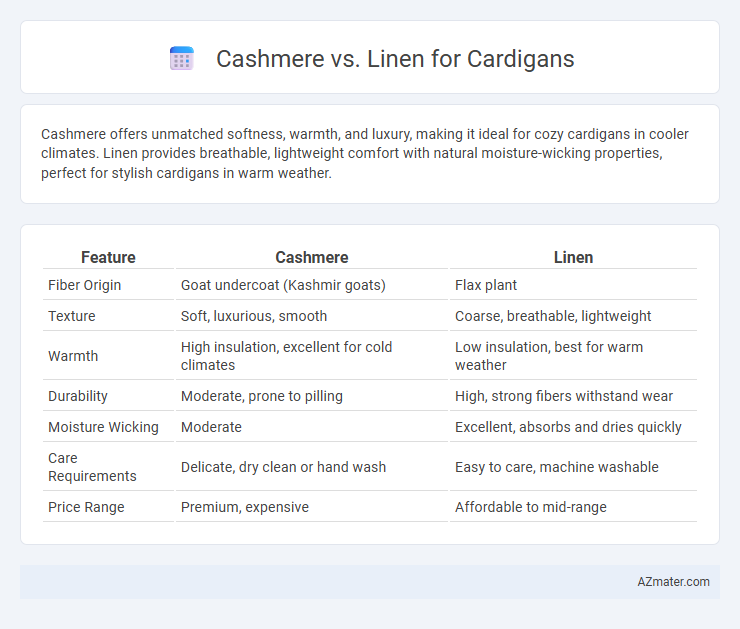Cashmere offers unmatched softness, warmth, and luxury, making it ideal for cozy cardigans in cooler climates. Linen provides breathable, lightweight comfort with natural moisture-wicking properties, perfect for stylish cardigans in warm weather.
Table of Comparison
| Feature | Cashmere | Linen |
|---|---|---|
| Fiber Origin | Goat undercoat (Kashmir goats) | Flax plant |
| Texture | Soft, luxurious, smooth | Coarse, breathable, lightweight |
| Warmth | High insulation, excellent for cold climates | Low insulation, best for warm weather |
| Durability | Moderate, prone to pilling | High, strong fibers withstand wear |
| Moisture Wicking | Moderate | Excellent, absorbs and dries quickly |
| Care Requirements | Delicate, dry clean or hand wash | Easy to care, machine washable |
| Price Range | Premium, expensive | Affordable to mid-range |
Overview: Cashmere vs Linen Cardigans
Cashmere cardigans are renowned for their exceptional softness, warmth, and luxurious feel, making them ideal for cooler weather and layering. Linen cardigans offer breathability, lightweight comfort, and moisture-wicking properties, suited for warmer climates and casual wear. Choosing between cashmere and linen depends on the desired balance between insulation and airflow, as well as seasonal versatility.
Fabric Origins and Production
Cashmere cardigans derive from the fine undercoat fibers of Cashmere goats native to the Himalayan regions, where meticulous hand-combing ensures their luxurious softness and warmth. Linen cardigans originate from the flax plant, primarily cultivated in Europe, with fibers extracted through retting and mechanical processing to create breathable, durable textiles. The production of Cashmere involves labor-intensive sorting and spinning, while Linen fabric requires retting, drying, and weaving, resulting in distinctly different textures and performance qualities.
Texture and Comfort Comparison
Cashmere cardigans offer an incredibly soft and luxurious texture, providing exceptional warmth and a lightweight feel that makes them ideal for cooler weather. Linen cardigans, by contrast, feature a breathable and slightly rougher texture, promoting excellent airflow and moisture-wicking properties suitable for warmer climates. Comfort-wise, cashmere excels in plush softness and insulation, while linen stands out for its cool, airy sensation and durability.
Breathability and Climate Suitability
Cashmere cardigans offer exceptional softness and warmth, making them ideal for cooler climates but less breathable compared to linen. Linen cardigans provide superior breathability and moisture-wicking properties, making them perfect for hot and humid weather. Choosing between cashmere and linen depends on prioritizing warmth versus ventilation for optimal comfort in varying climates.
Durability and Longevity
Cashmere cardigans offer exceptional softness and insulation but are more delicate, requiring careful hand washing to maintain their durability and longevity. Linen cardigans are highly durable and breathable, with fibers that become stronger over time, making them ideal for long-lasting wear in warmer climates. Choosing between cashmere and linen depends on prioritizing luxurious softness versus resilient, easy-care fabric.
Style Versatility and Aesthetics
Cashmere cardigans offer a luxurious, soft texture and a refined appearance that elevates both casual and formal outfits, making them highly versatile for various occasions. Linen cardigans showcase a breathable, lightweight fabric with a natural, relaxed drape, perfect for warm weather and effortlessly stylish summer layering. The rich warmth and smooth finish of cashmere contrast with linen's crisp, textured look, allowing each fabric to create distinct aesthetic appeals depending on seasonal and style preferences.
Maintenance and Care Requirements
Cashmere cardigans require gentle hand washing or dry cleaning to maintain their softness and prevent fiber damage, while linen cardigans can withstand machine washing but need prompt air drying to avoid wrinkles and shrinkage. Cashmere fibers are delicate and prone to pilling, necessitating careful storage in breathable garment bags and occasional de-pilling with a fabric comb. Linen's natural fibers are durable but prone to creasing, so ironing on low heat while damp is recommended to preserve a smooth appearance.
Price Range and Value for Money
Cashmere cardigans typically range from $150 to over $1,000, offering exceptional softness, warmth, and durability, which justifies the higher price due to the luxury and longevity of the material. Linen cardigans are more affordable, generally priced between $40 and $150, providing excellent breathability and lightweight comfort ideal for warmer weather but with less insulation and less durability compared to cashmere. Choosing between the two depends on budget and intended use; cashmere delivers premium value for long-term wear and warmth, while linen offers cost-effective versatility for casual, summer-friendly layers.
Ethical and Sustainability Considerations
Cashmere cardigans often face scrutiny due to the environmental impact of goat farming, which can lead to land degradation and high water usage, raising ethical concerns about sustainability. Linen cardigans, derived from flax plants, present a more eco-friendly alternative by requiring less water, fewer pesticides, and offering biodegradability, supporting sustainable fashion practices. Consumers seeking ethical wardrobe choices frequently prefer linen for its renewable cultivation and lower carbon footprint compared to the resource-intensive production of cashmere.
Choosing the Right Cardigan: Cashmere or Linen?
Cashmere cardigans offer exceptional softness, warmth, and durability, making them ideal for cooler weather and luxurious comfort, while linen cardigans provide breathability, moisture-wicking properties, and lightweight feel perfect for warmer climates and casual wear. Cashmere is derived from the undercoat of cashmere goats, featuring fine fibers that trap heat efficiently, whereas linen is made from flax fibers known for their strength and cooling effect. Selecting the right cardigan depends on climate, desired texture, and occasion, with cashmere suited for insulation and elegance, and linen favored for ventilation and relaxed style.

Infographic: Cashmere vs Linen for Cardigan
 azmater.com
azmater.com